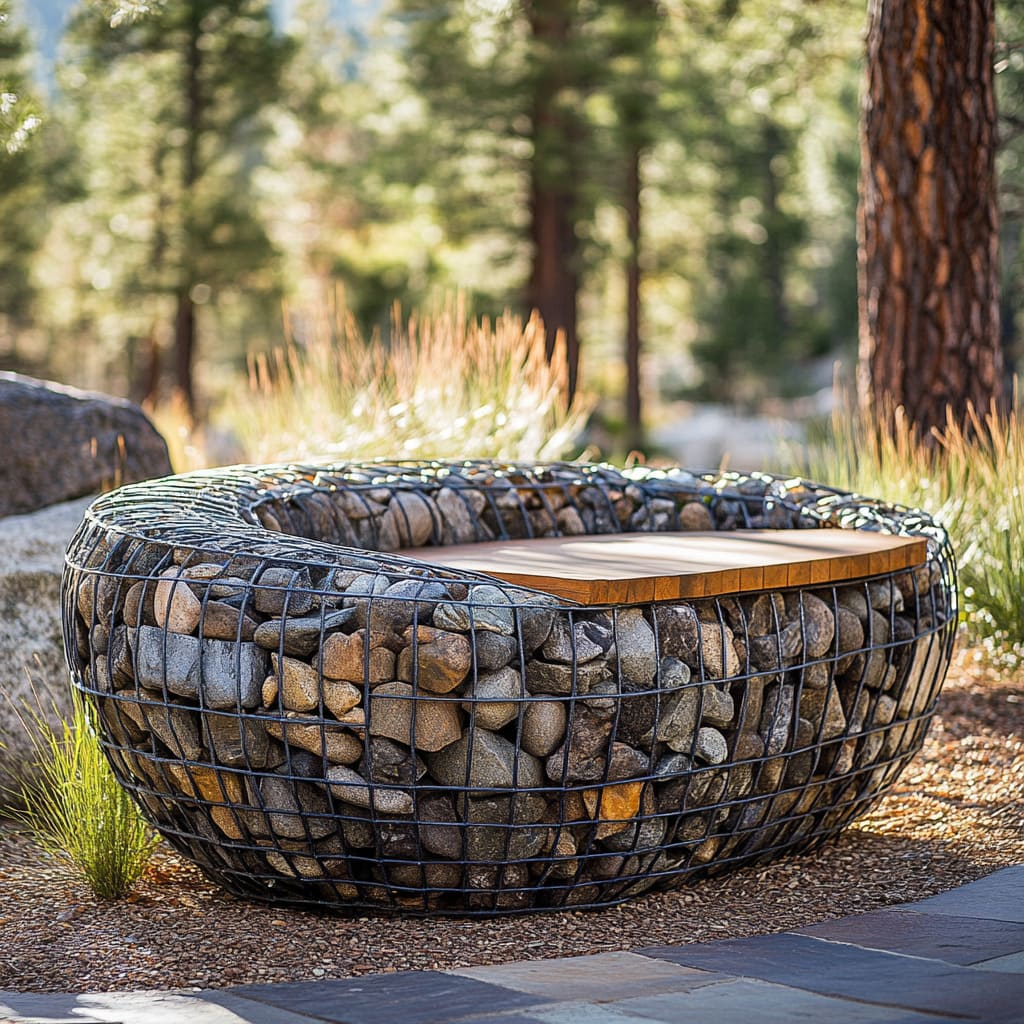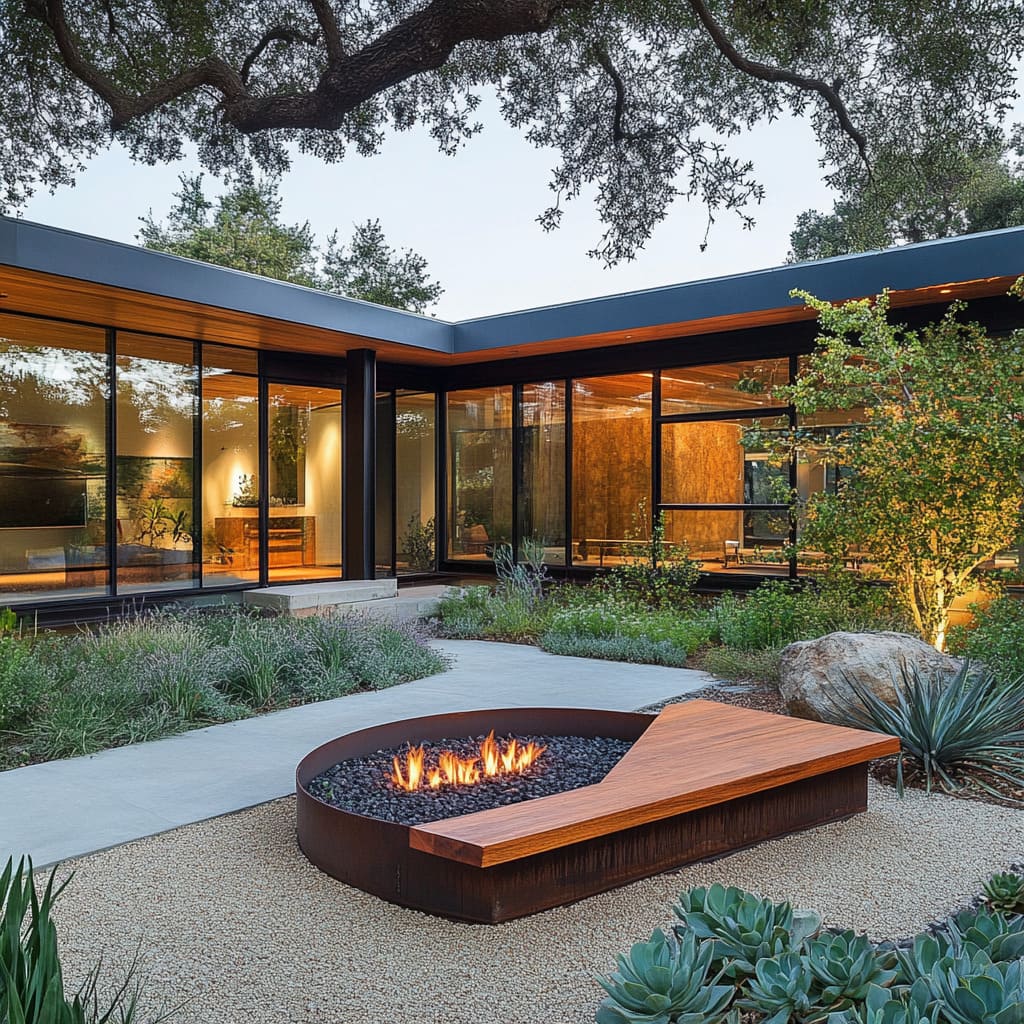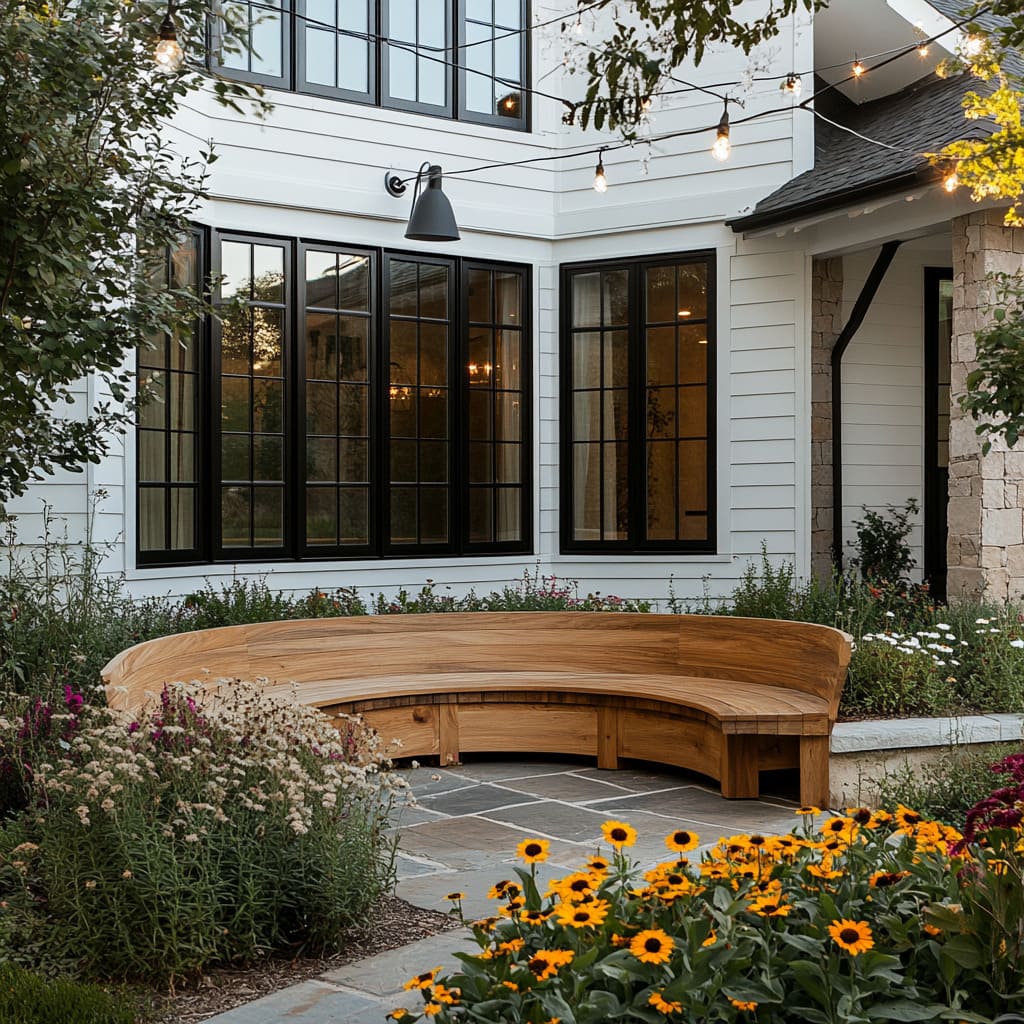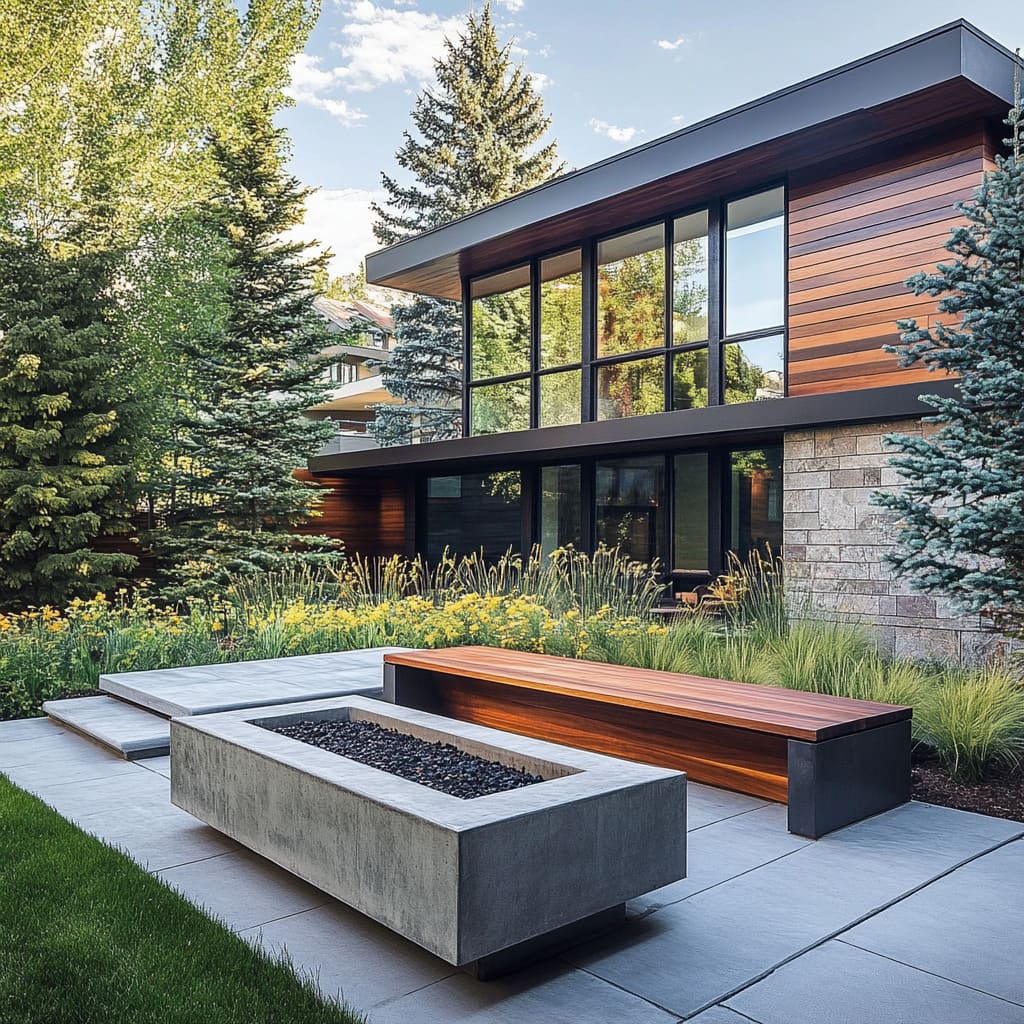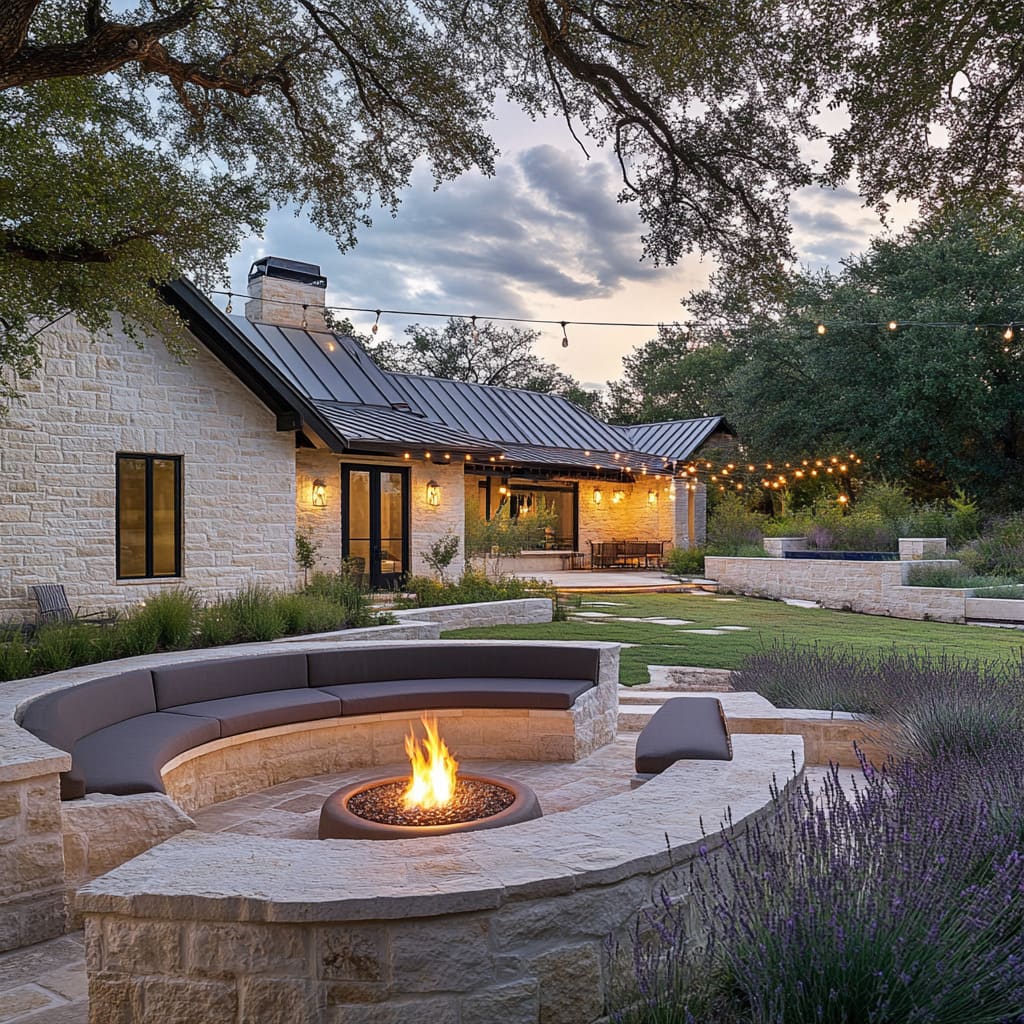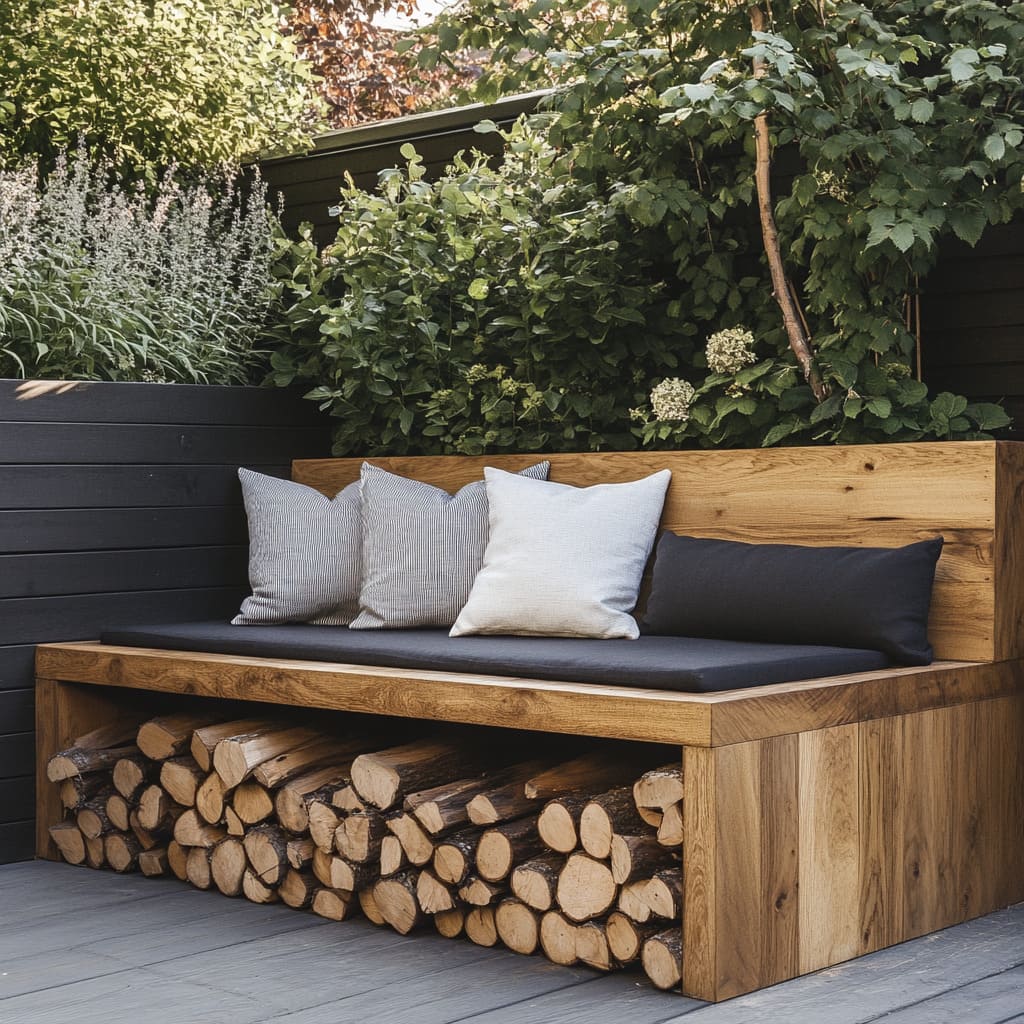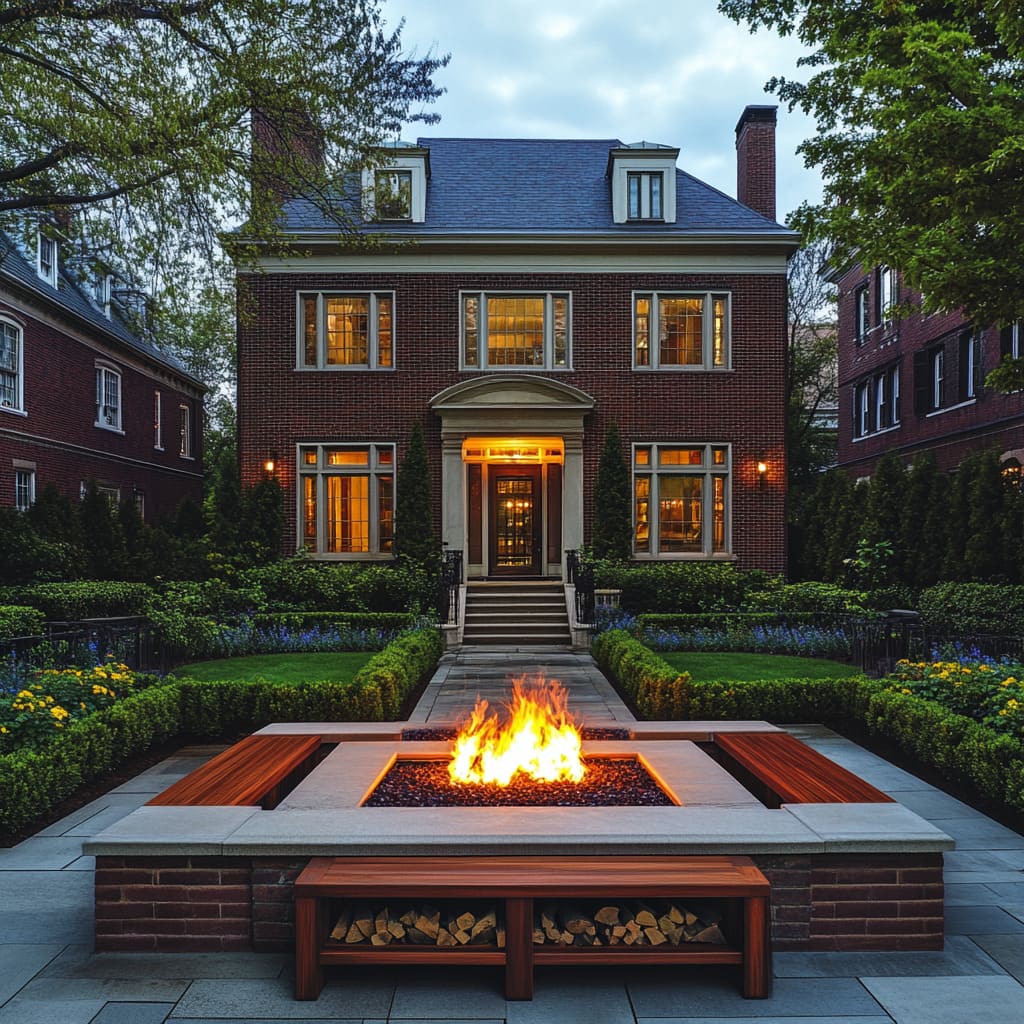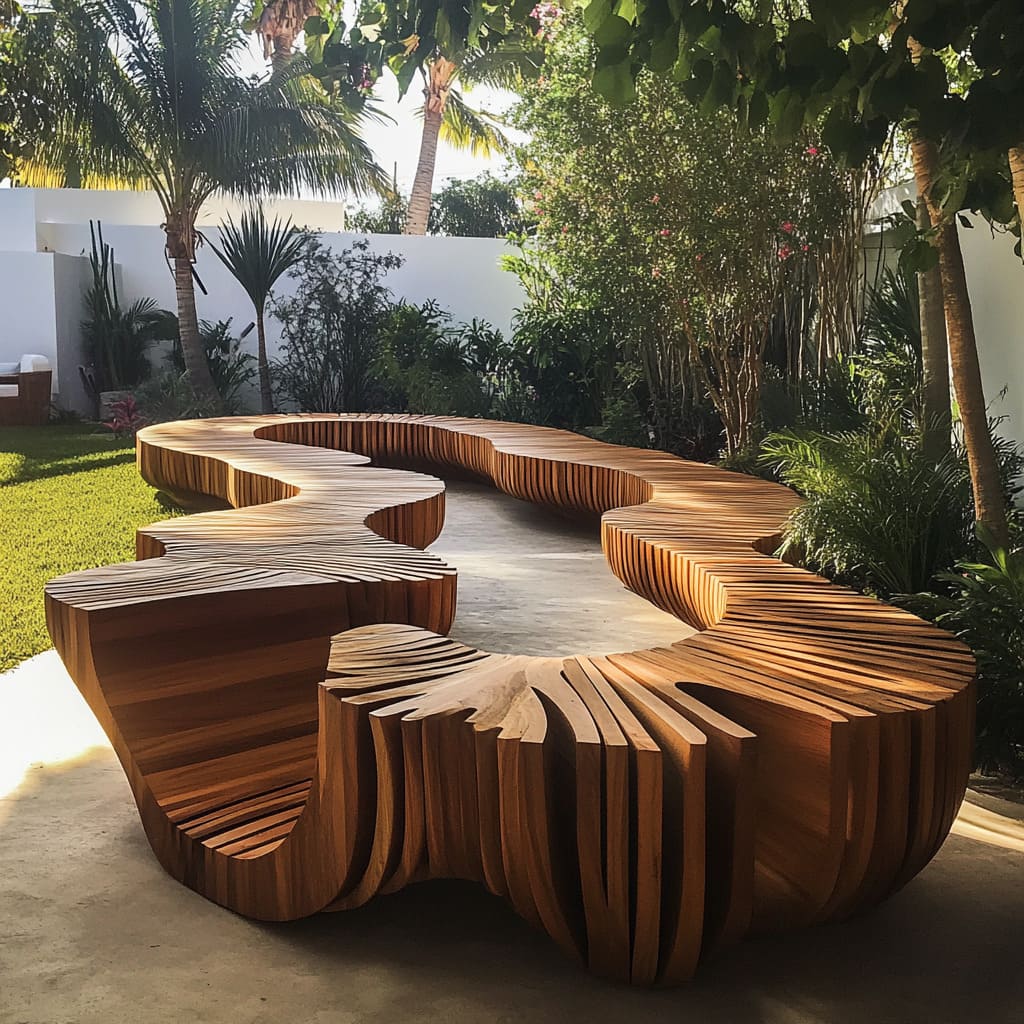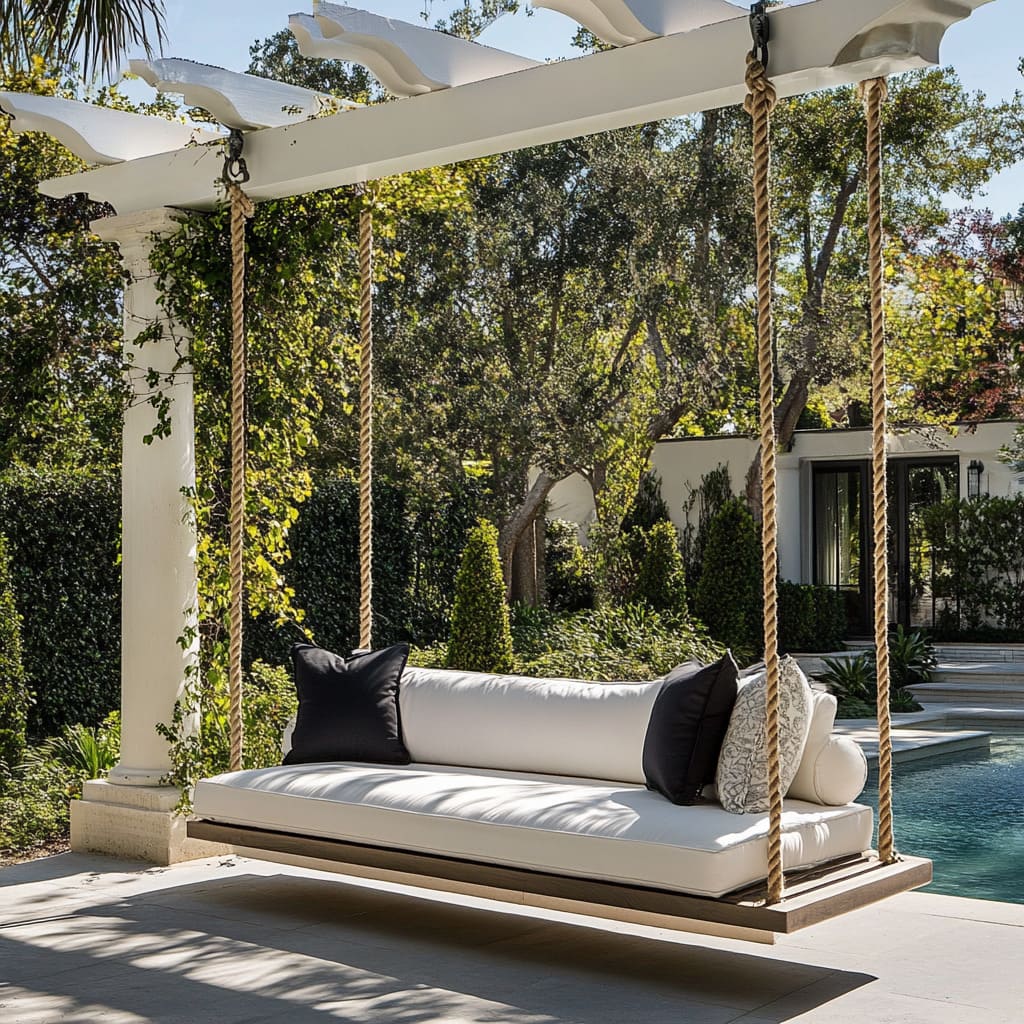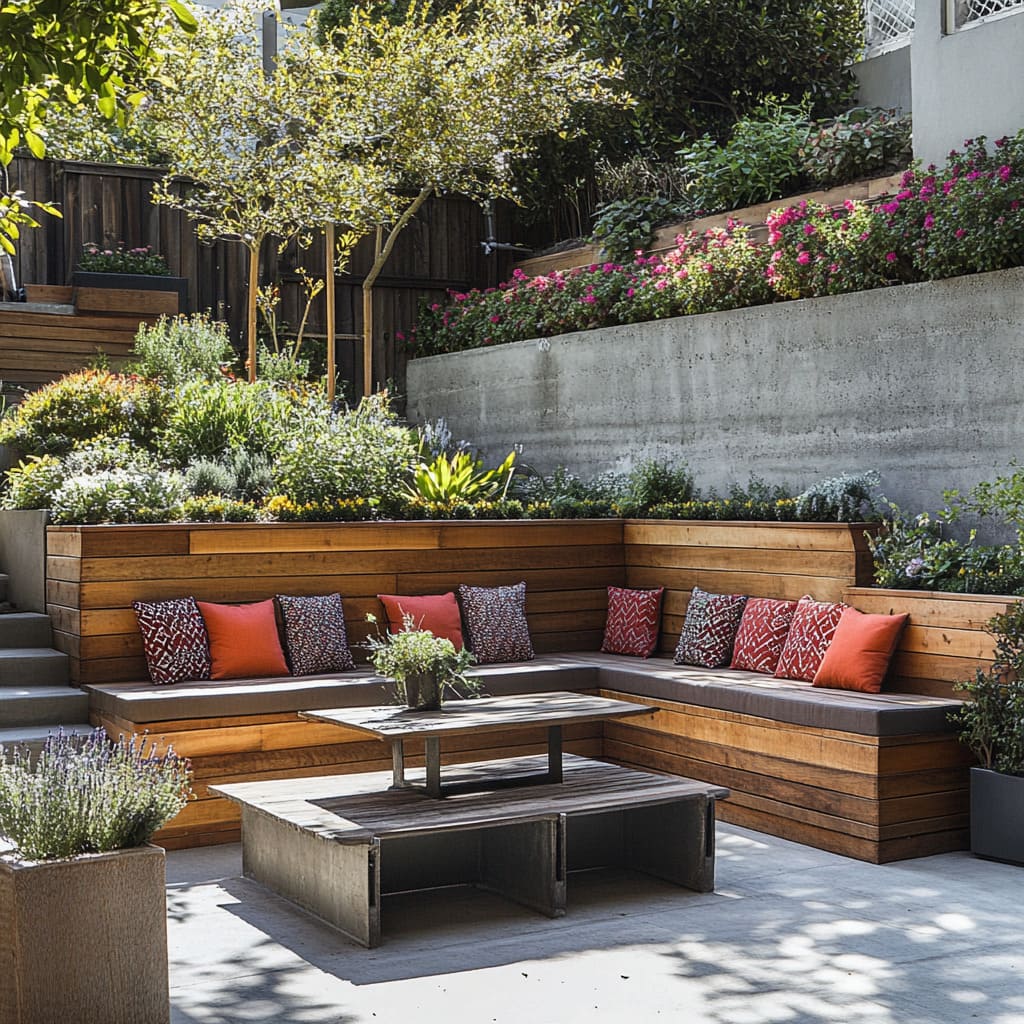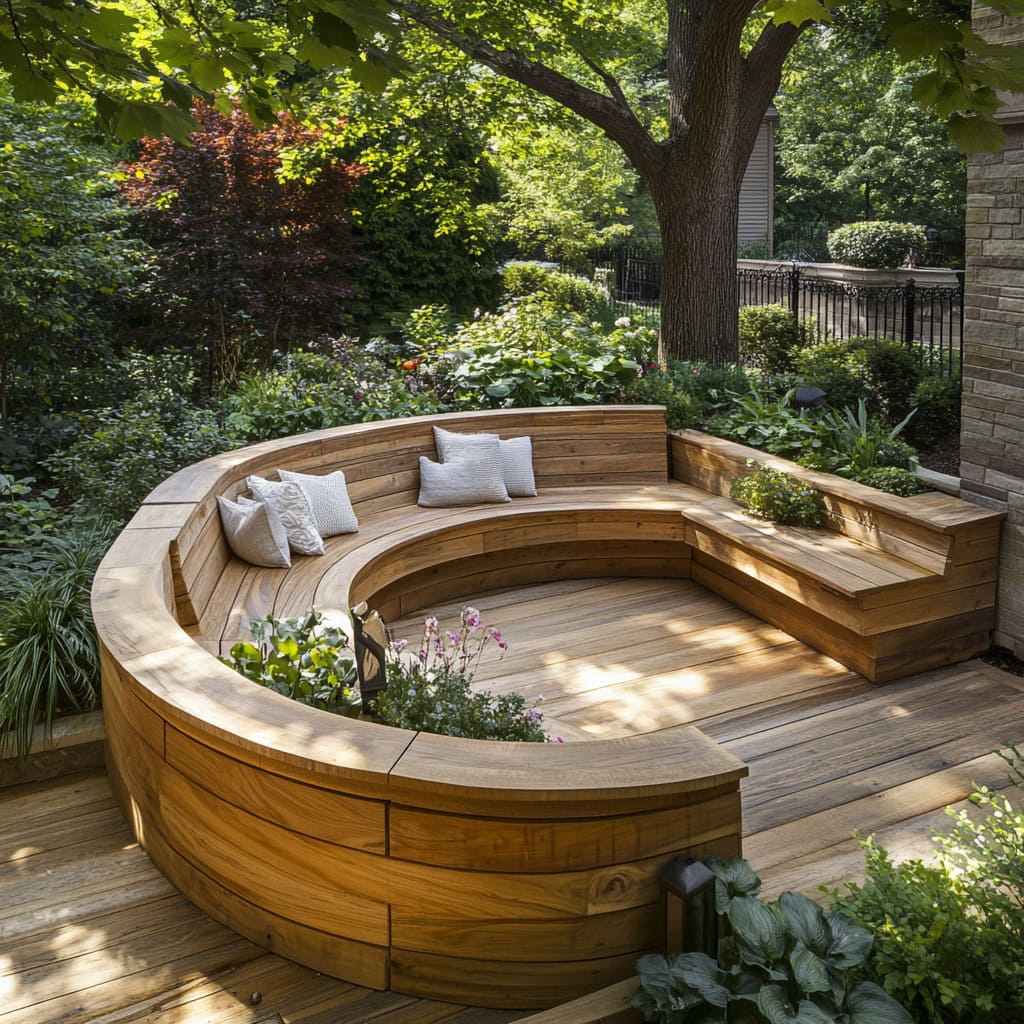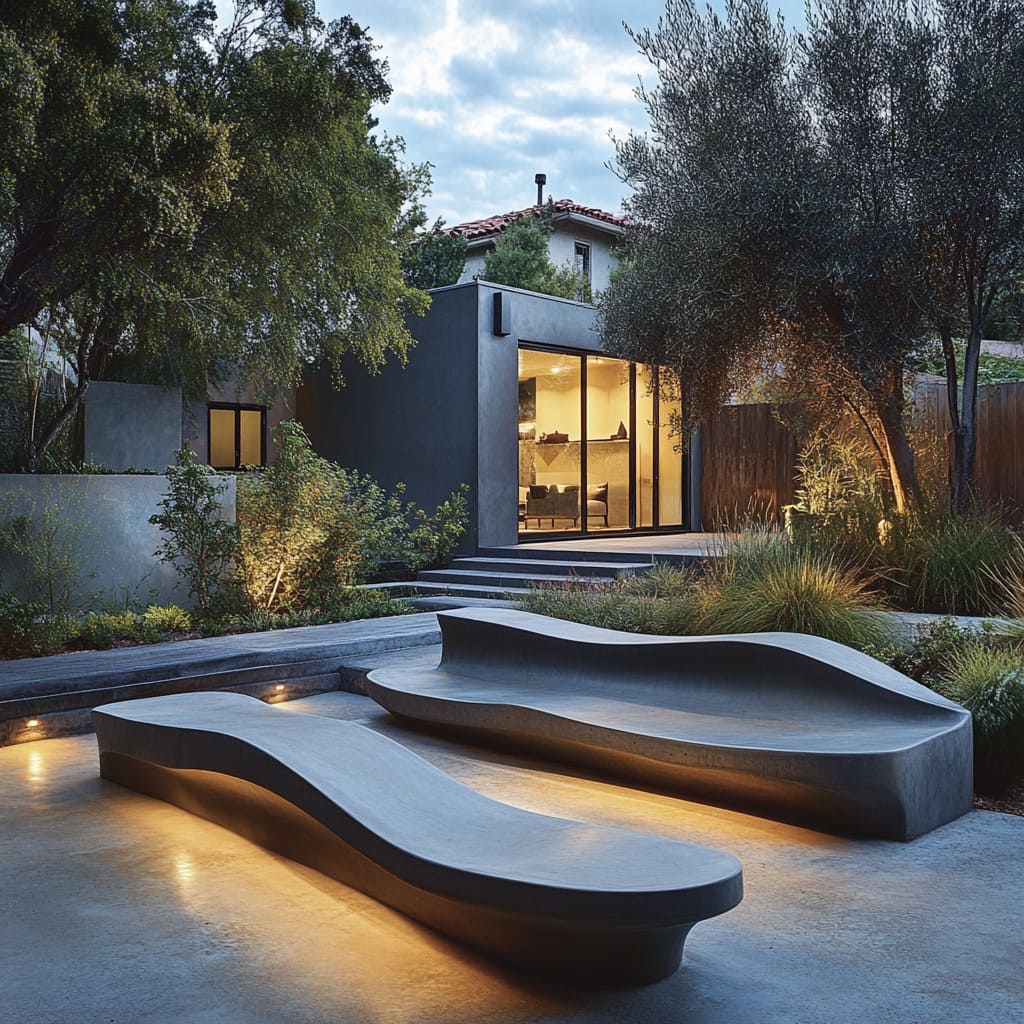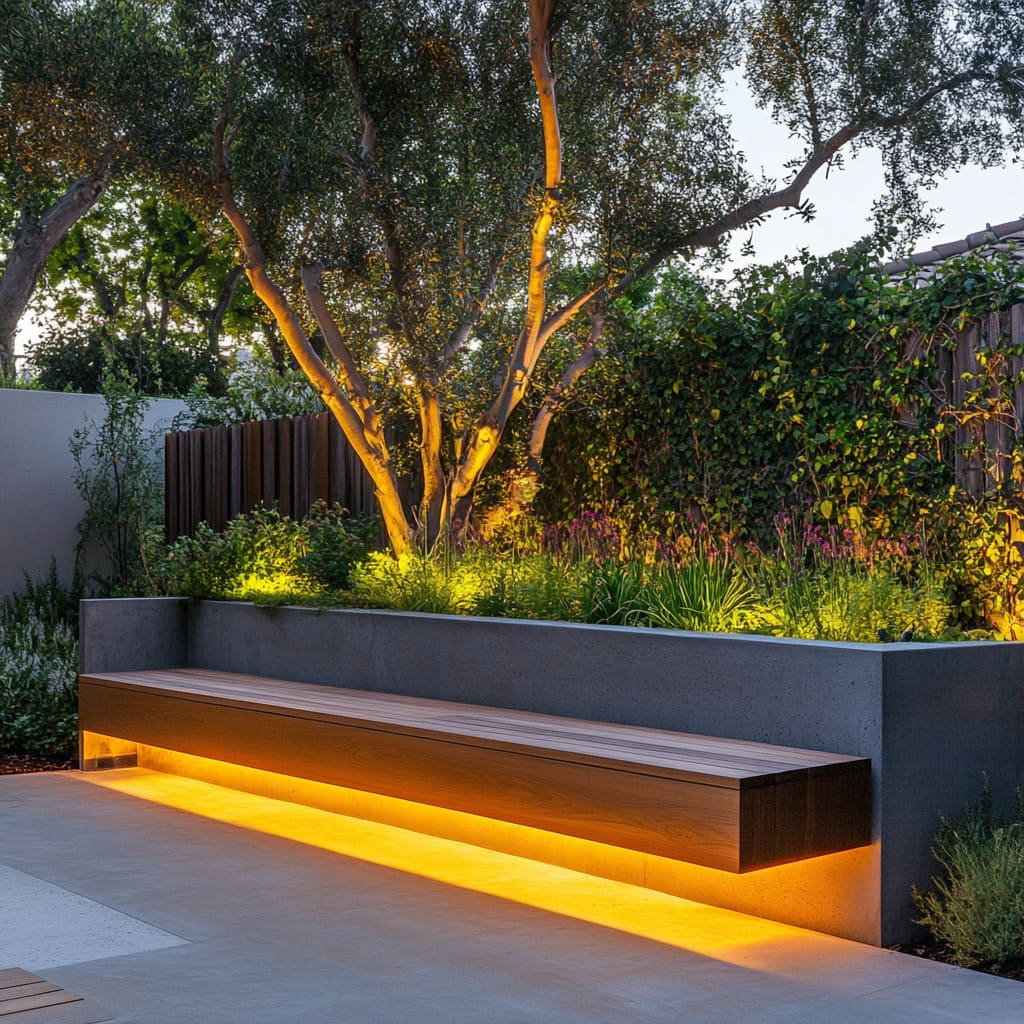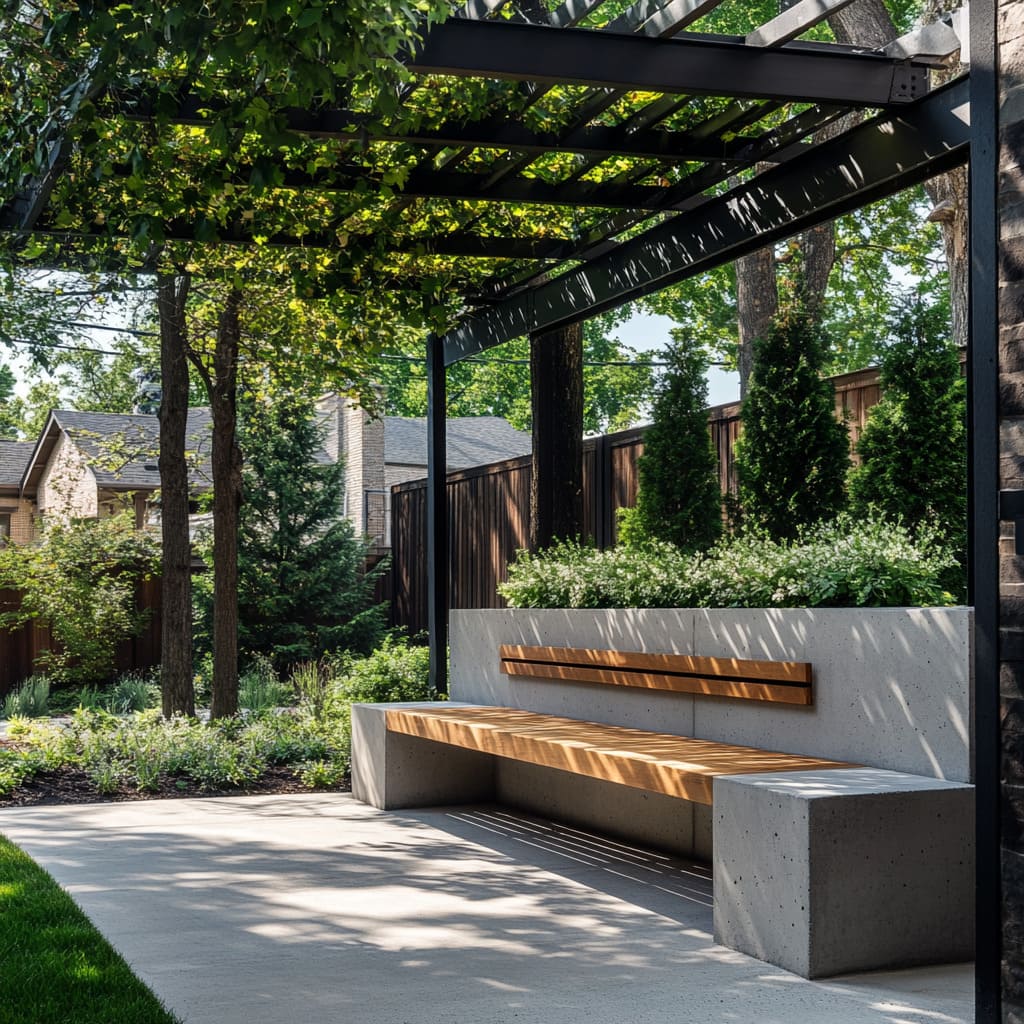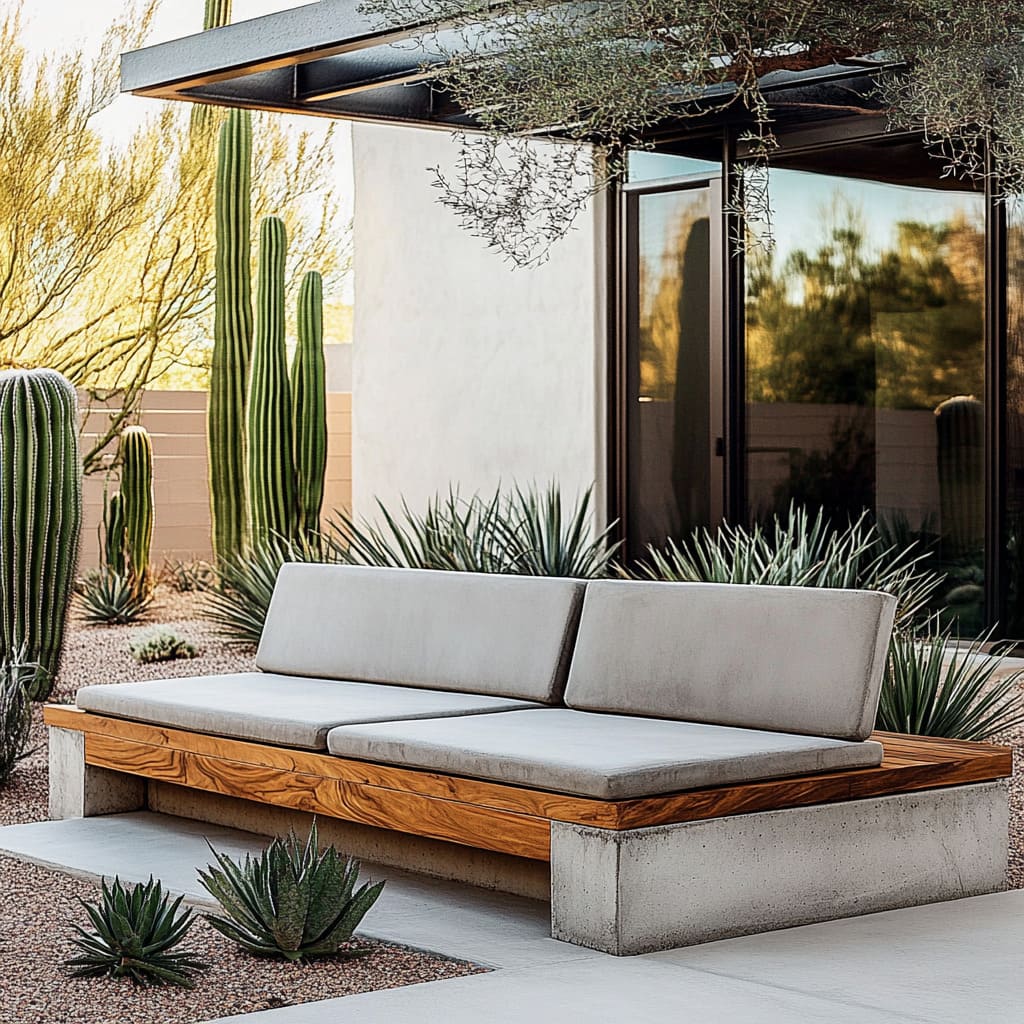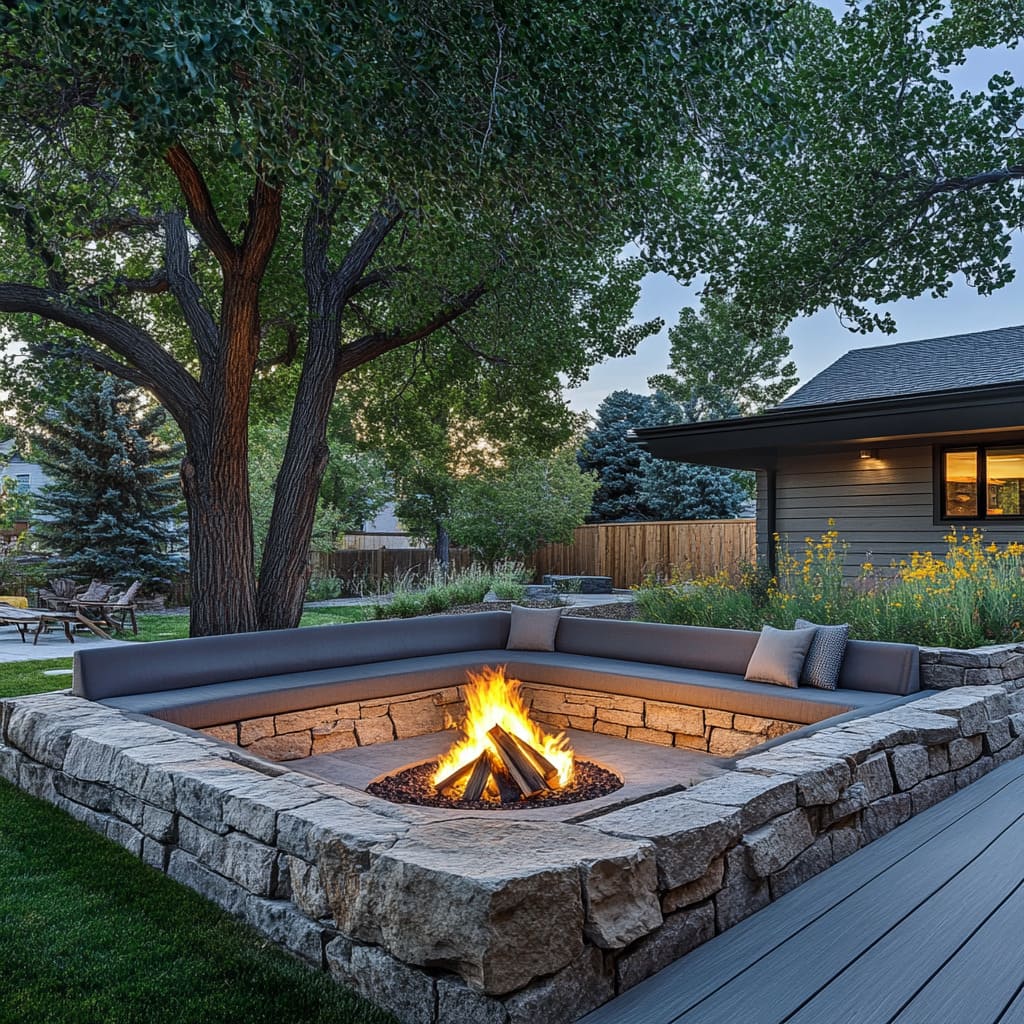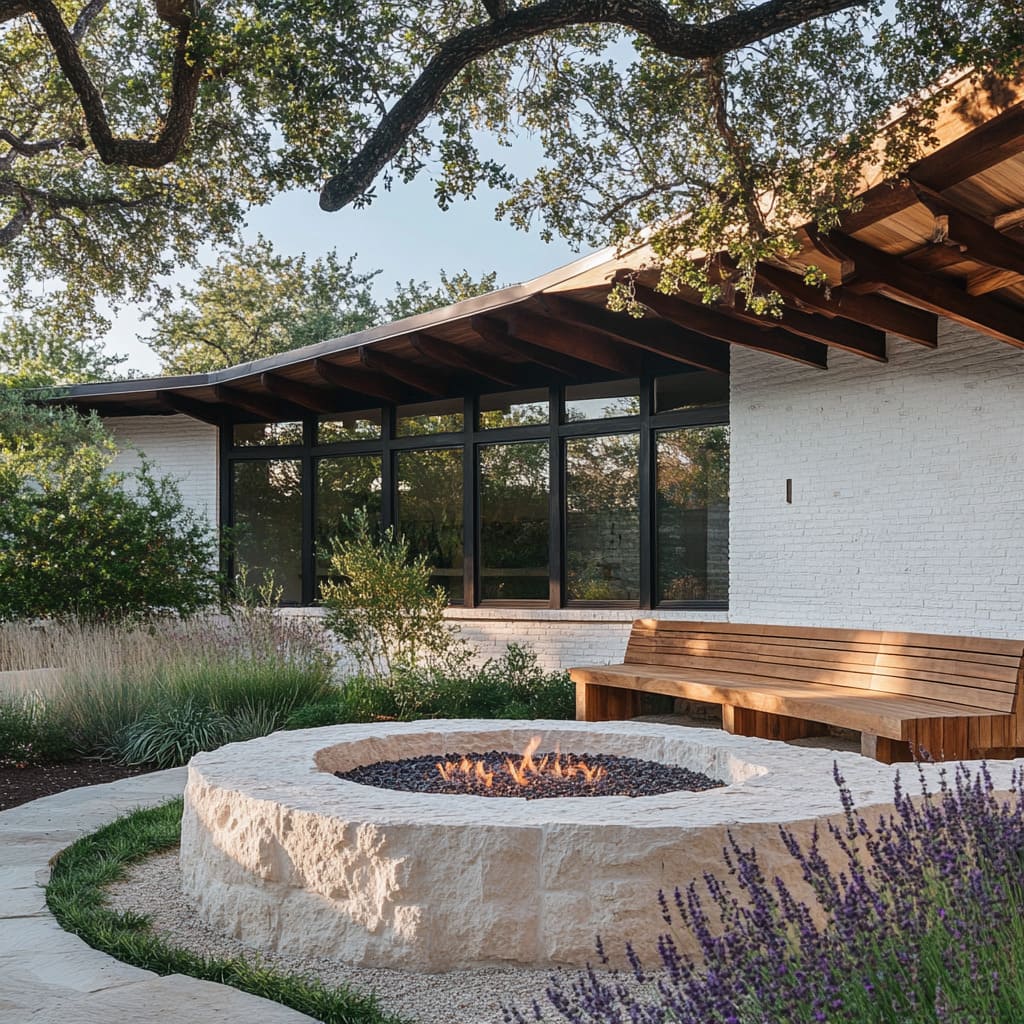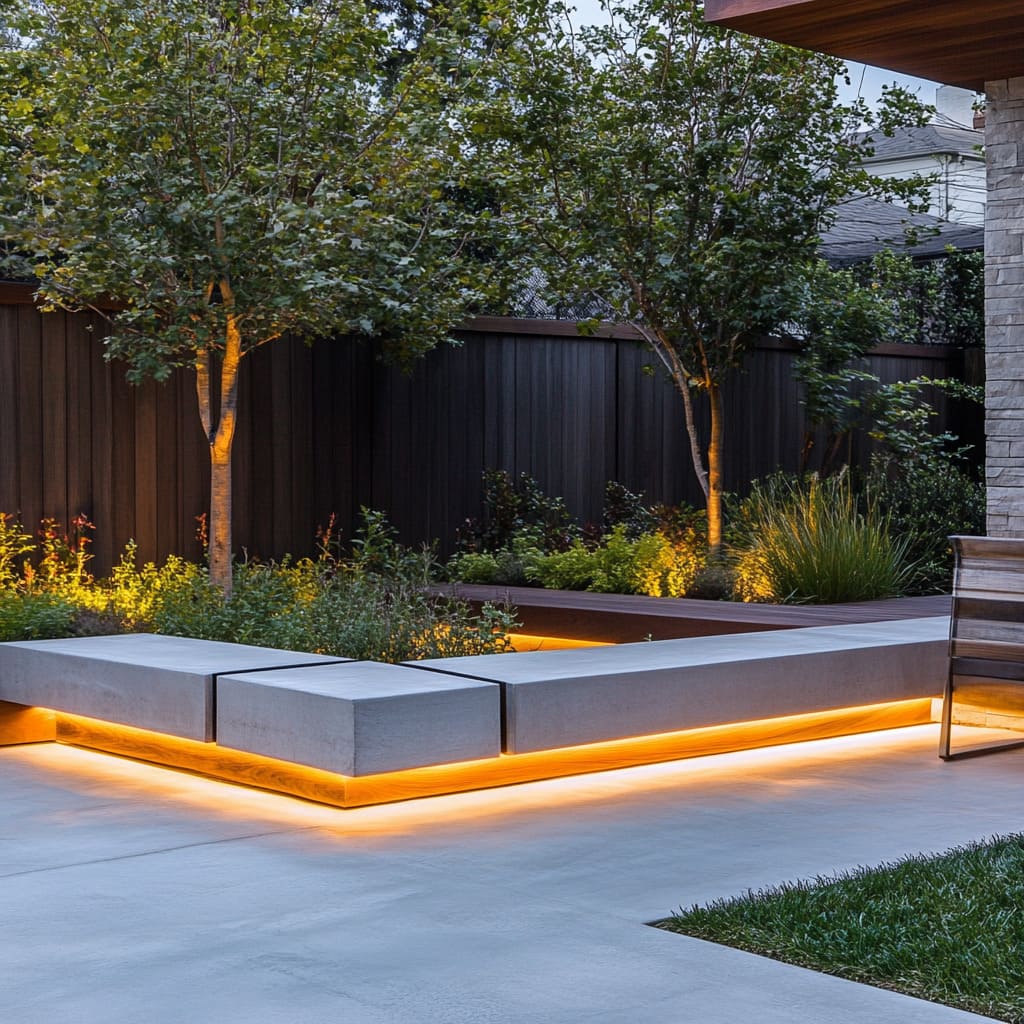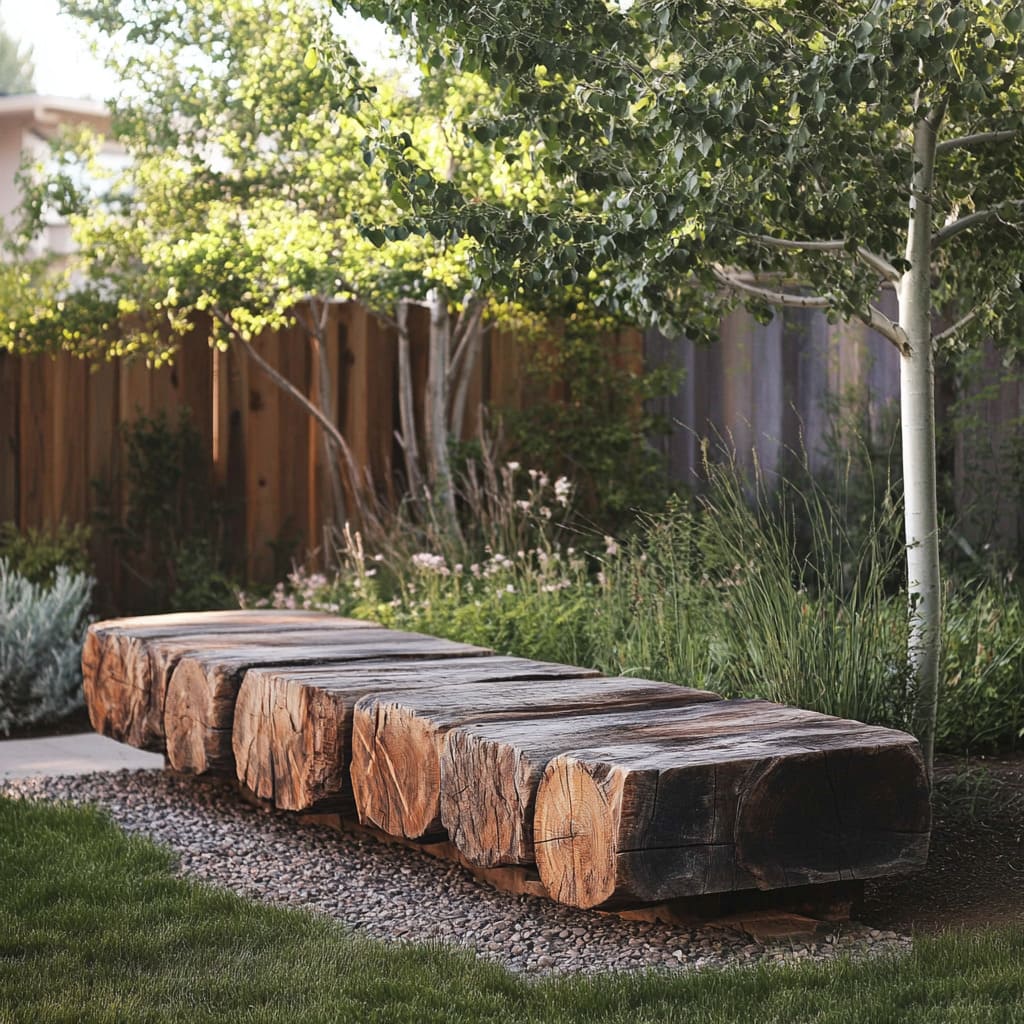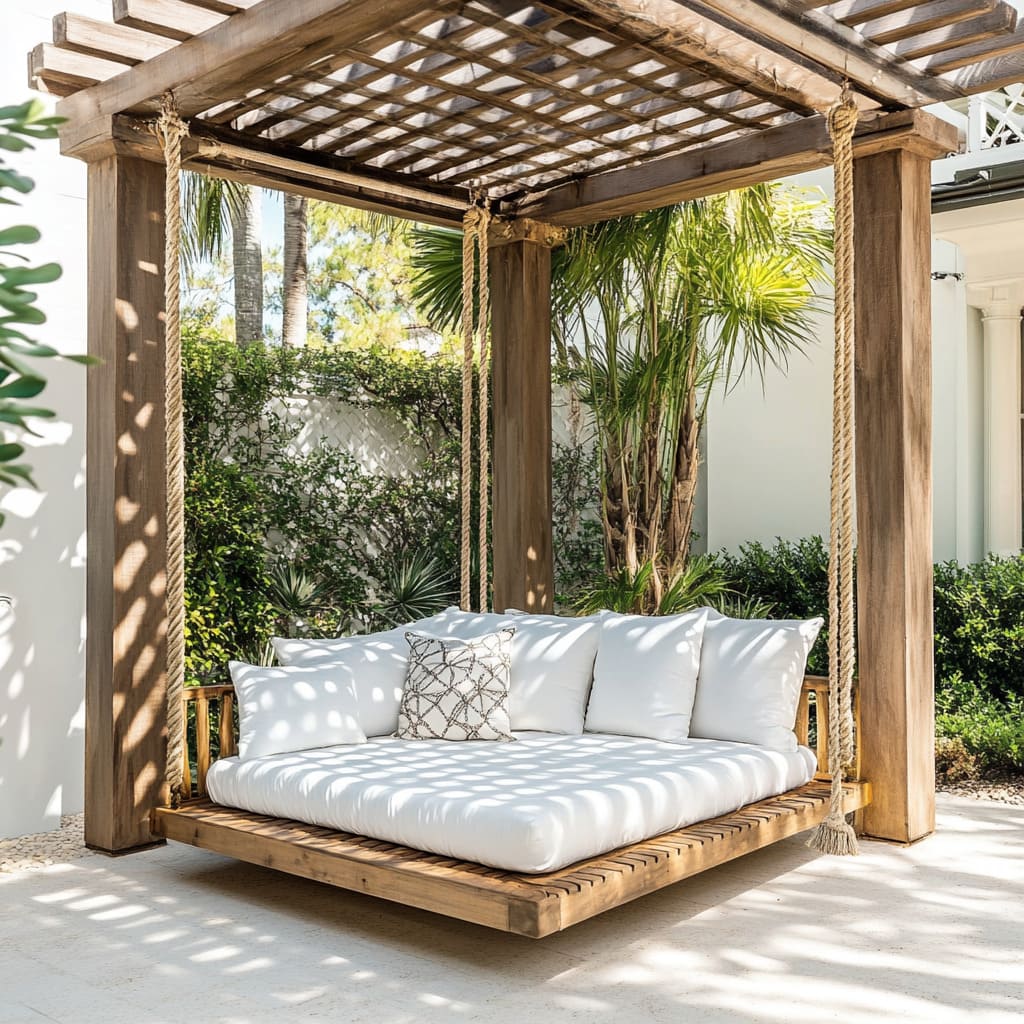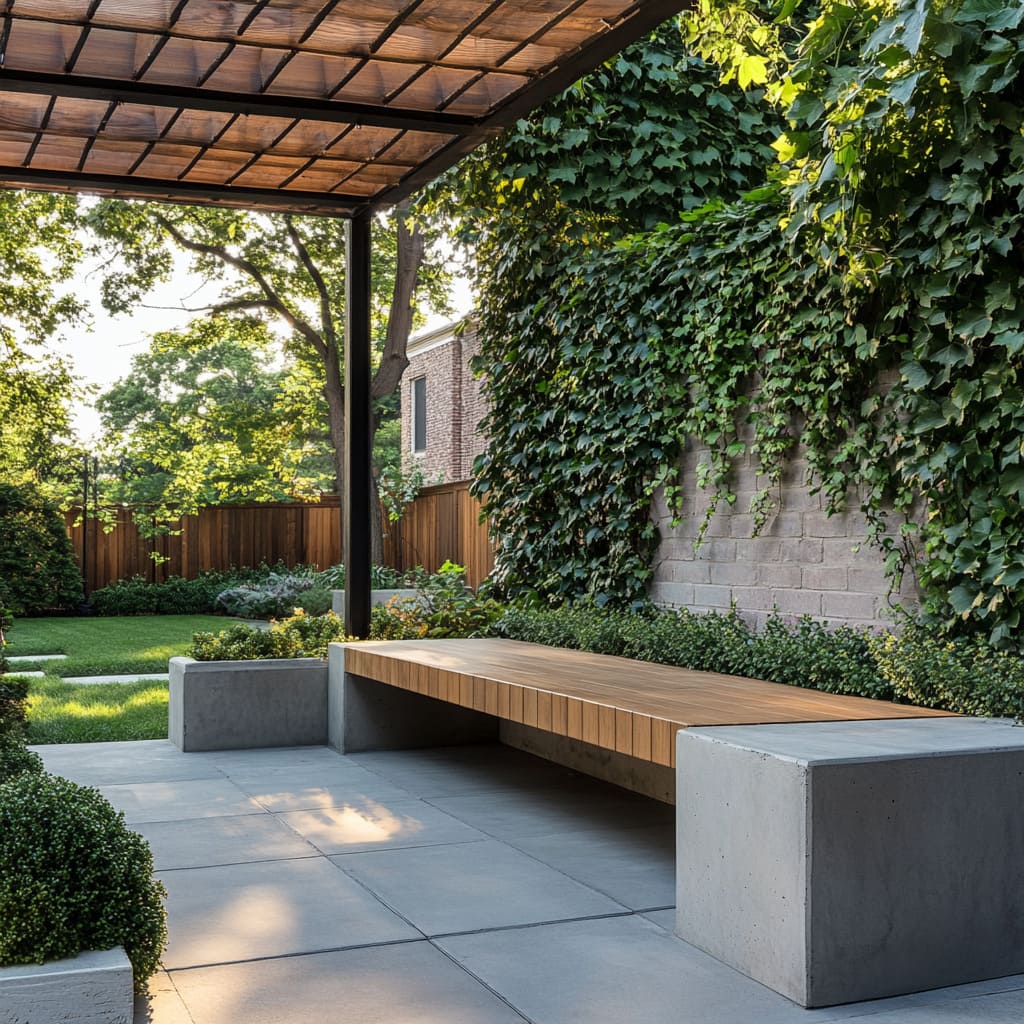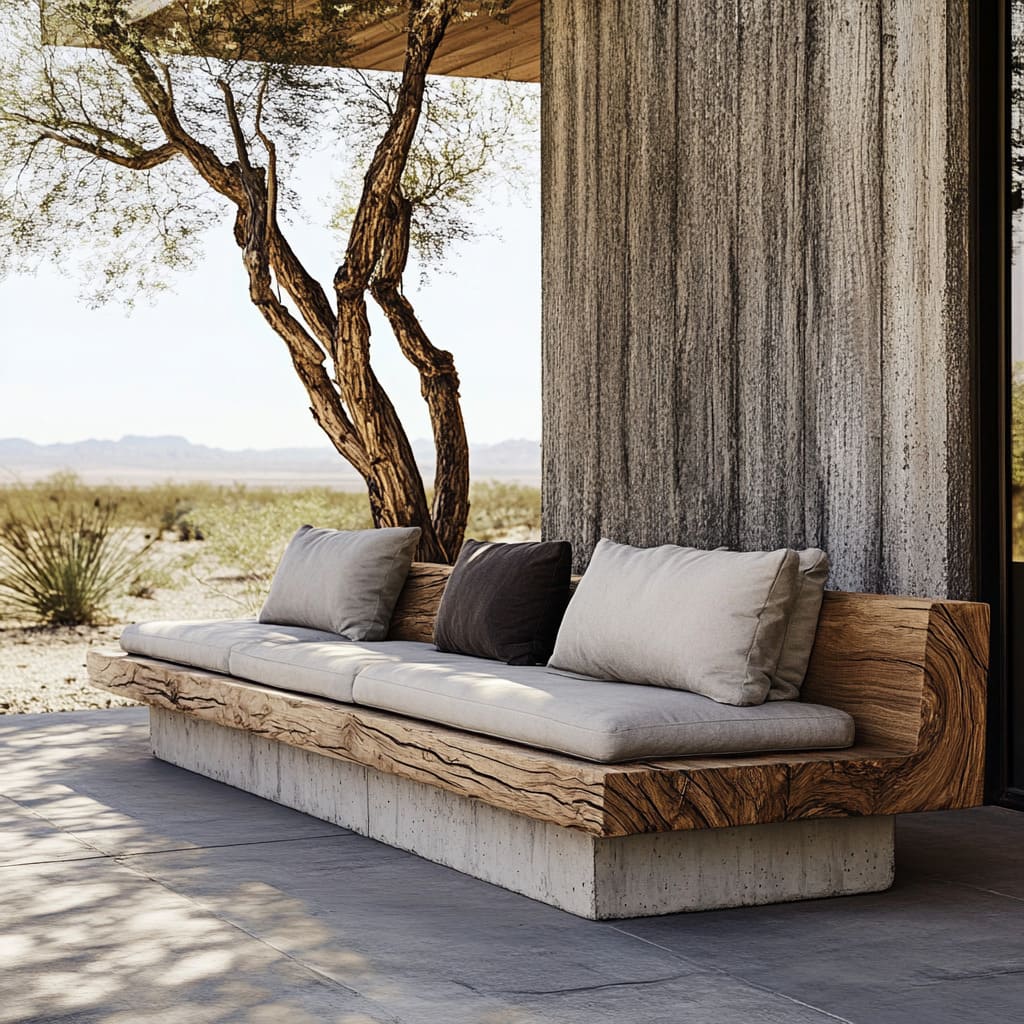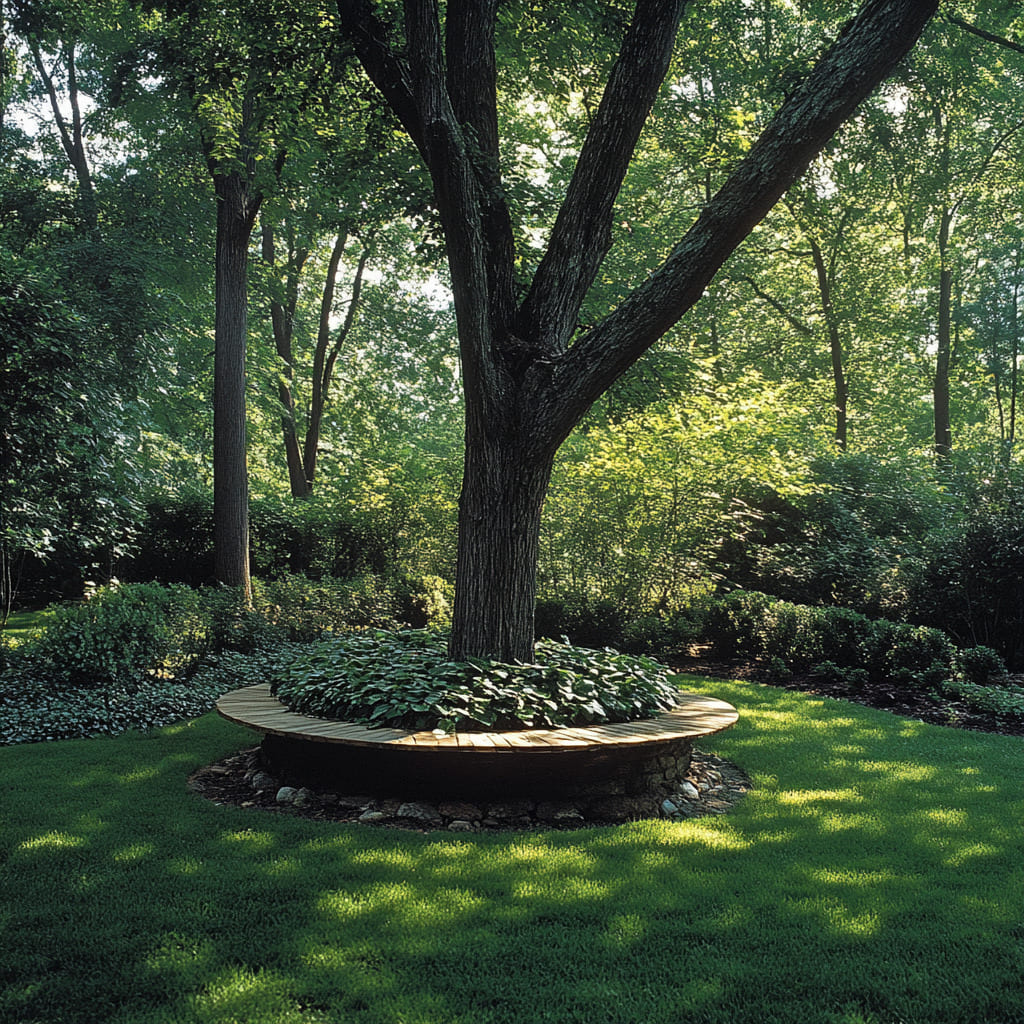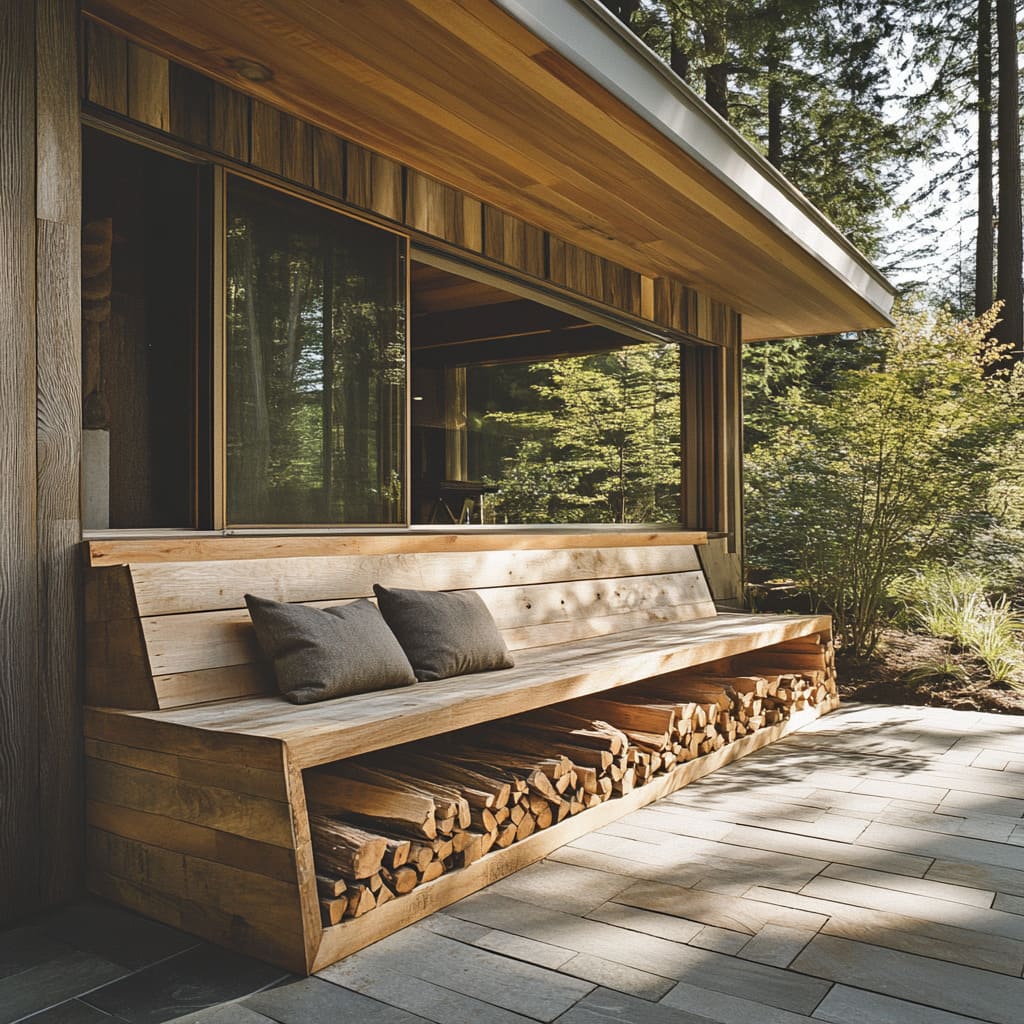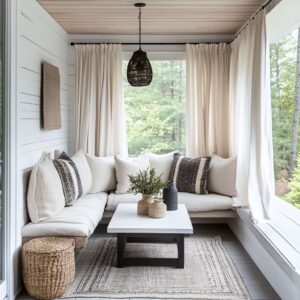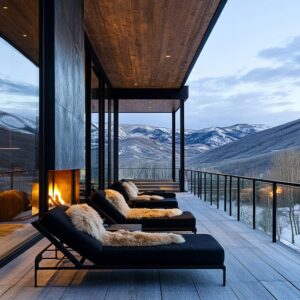Creating a backyard bench isn’t just about adding seating—it’s about shaping the way you experience your outdoor space. Whether you’re looking for a cozy retreat surrounded by greenery or a statement piece that blends into a modern landscape, the right garden bench design ideas can enhance both comfort and style.
This article breaks down key elements like materials, layout, and how benches integrate with landscaping, while also covering practical aspects like durability and maintenance. By the end, you’ll have a clear understanding of what works best for your space, climate, and personal style, with plenty of inspiration to craft a bench that not only fits your backyard but also makes it more inviting.
Balancing Materials with Climate and Aesthetic
Choosing the right materials for a backyard bench is more than a style decision—it directly affects comfort, longevity, and how well the bench blends into the environment. Whether positioned under a shady tree, near a fire pit, or as part of a larger patio setup, the right material choice ensures that the bench remains functional and visually appealing throughout the seasons.
Wood and Concrete Combinations
Pairing wood with concrete is one of the most practical approaches in outdoor bench designs, offering a mix of durability and warmth. Concrete provides a solid base that withstands weather extremes, while wood adds a natural touch that feels inviting.
In modern patio layouts, a concrete bench with a wooden seating plank can seamlessly integrate into the hardscape, as seen in designs where the bench extends from a planter wall or wraps around a fire pit. The wood softens the otherwise rigid structure, making the seating area more comfortable while maintaining a clean, architectural look.
This combination works exceptionally well in dry, sun-drenched locations. Concrete’s ability to resist cracking and erosion in sandy or arid settings makes it an excellent structural material, but sitting directly on a solid concrete surface can be uncomfortable, especially in intense heat.
This is where wood, particularly a live-edge slab, becomes useful—it doesn’t absorb as much heat, making it a more pleasant surface during the day. The contrast between raw concrete and rich, textured wood also adds visual interest, creating a focal point in modern landscapes.
For homeowners looking to create a striking outdoor feature, floating concrete benches with underglow lighting offer both function and atmosphere. By slightly elevating the wooden seat with hidden supports, these designs create the illusion of weightlessness, especially when paired with warm LED lighting underneath.
This type of bench is ideal for patios and entertainment spaces where modern style meets practical outdoor living.
Fully Wooden Designs
Wood remains one of the most versatile choices, lending itself to both contemporary and rustic settings. The material’s ability to weather naturally and develop character over time makes it appealing, especially in gardens where organic textures complement the surroundings.
In a cottage-style garden, a curved wooden bench can be positioned to follow the flow of flower beds or pathways, creating an intimate seating area that feels connected to nature. Meanwhile, in a more rugged setting, thick log benches cut from naturally aged wood fit seamlessly into woodland landscapes.
The key to longevity with wooden benches is choosing the right species. In humid or rainy climates, woods like teak, cedar, and redwood offer the best resistance to moisture and insects.
Teak, in particular, is prized for its dense grain and natural oils that repel water, making it a common choice for outdoor furniture. However, even the most durable wood benefits from occasional sealing or oiling to maintain its color and prevent cracking.
For a more refined look, slatted wooden benches with smooth, polished surfaces can be designed to fit within structured gardens or alongside pergolas. In these setups, the balance between craftsmanship and function comes into play, with benches often doubling as decorative elements.
Adding cushions or built-in backrests can enhance comfort, especially if the bench is meant for extended use.
Stone and Gabion Cages
For a more rugged or earthy aesthetic, stone benches and gabion cage designs bring a structural quality that blends with natural landscapes. These benches are particularly effective in areas where local stone is abundant, allowing the material to feel naturally embedded in the environment.
Gabion cage benches, made by filling metal mesh frames with river rocks or crushed stone, offer a visually striking contrast between rough and smooth textures. The weight of the stones provides stability, making these benches ideal for wind-exposed areas or places where furniture needs to stay firmly in place.
A wooden or concrete slab on top ensures comfortable seating while keeping the design practical. In fire pit setups, stacked stone benches provide a seamless transition from seating to structural elements, making them a natural choice for outdoor lounge areas.
Limestone and granite are commonly used due to their ability to withstand temperature fluctuations. Additionally, integrating lighting or small planters into the stonework can soften the overall appearance, keeping the bench from feeling too heavy in the space.
While stone requires little maintenance compared to wood, gabion cages should be checked periodically for rust in humid or coastal regions. Using galvanized or coated wire helps extend their lifespan, making them a more durable long-term option.
Choosing the Right Material for Your Setting
Each material has its strengths, and the best choice depends on the climate, the surrounding landscape, and how the bench will be used. Wood brings warmth and adaptability, concrete offers structure and durability, and stone grounds the space with a timeless presence.
Mixing materials often results in the best balance, ensuring the bench not only looks great but also remains comfortable and functional over time.
Shapes and Overall Layout
The shape of a backyard bench isn’t just about looks—it influences how people interact, how space is used, and how well the design fits within the landscape. Whether creating a cozy gathering spot, a striking modern feature, or a practical multi-level seating area, the form of the bench plays a major role in both function and atmosphere.
Circular Configurations for Social Connection
Curved seating encourages a natural flow of conversation, making it a popular choice for spaces designed for gatherings. A garden wood bench design that wraps around a tree is a perfect example—this type of bench provides 360-degree seating while integrating the trunk as part of the design.
Beyond trees, circular or semi-circular benches work well around fire pits or sunken lounge areas, creating an enclosed, inviting space where people naturally face each other. For those who love hosting, a recessed deck with built-in wraparound seating offers a similar effect, framing the seating area while making use of every inch.
Whether using wood, stone, or a mix of materials, curved benches bring a sense of unity and connection, making them ideal for relaxed social settings.
Straight Lines and Sharp Angles
For a more contemporary look, benches with clean lines and structured angles fit seamlessly into modern outdoor spaces. A rectangular bench positioned along a pathway or patio edge creates a refined look, offering practical seating without disrupting the overall symmetry.
This approach is commonly seen in fire pit setups where the bench runs parallel to the flames, providing a structured seating arrangement that feels sleek and purposeful. In some cases, benches with sharp angles create dramatic visual impact.
Floating concrete benches or geometric wood-and-metal designs stand out as sculptural elements while maintaining a strong architectural presence. These work especially well in minimalist gardens where bold lines define the space.
If a more industrial aesthetic is desired, incorporating steel or dark-stained wood alongside these sharp forms enhances the structured look while keeping the space from feeling too rigid.
Hybrid and Tiered Concepts
When working with a sloped yard, benches can do more than provide seating—they can define levels within the space. A multi-tiered approach allows seating to be built directly into retaining walls or terraced gardens, making use of vertical space while maintaining a seamless flow.
This method is especially useful for outdoor dining areas, amphitheater-style lounge spots, or layered fire pit designs where different elevations create a more dynamic experience. Wooden benches built into these levels can follow the shape of the landscape, forming L-shaped or cascading seating areas that maximize functionality without overwhelming the natural surroundings.
Pairing these with integrated planters or lighting can further enhance the design, making the seating feel like an organic extension of the yard. No matter the shape, the key to a successful bench layout is how well it interacts with the rest of the space.
Circular designs encourage gathering, angular forms add definition, and tiered seating makes use of every level of the garden. Choosing the right shape ensures the bench isn’t just another feature, but a natural part of the backyard’s overall flow.
Merging Bench Designs with Surrounding Landscaping
A backyard bench should feel like it belongs in the space rather than standing out as an afterthought. The best designs blend effortlessly with their surroundings, using plants, shade structures, and natural contours to create a seamless transition between seating and landscape.
Whether nestled into lush greenery, built into a sunken fire pit area, or positioned under a pergola, a thoughtfully placed bench enhances both function and atmosphere.
Blending with Plant Life
One of the most effective ways to make a bench feel connected to its setting is by incorporating plants directly into the design. A circular bench built around a mature tree naturally integrates seating into the garden, turning the tree itself into a focal point.
This type of setup provides a shaded spot that feels inviting while also protecting the soil around the trunk from excessive foot traffic. Another approach is to combine seating with built-in planters, allowing foliage to soften the edges of hard materials like concrete or wood.
Some outdoor bench design ideas take this concept even further by embedding pockets of greenery within the structure itself, creating a living element that changes with the seasons. This works especially well for contemporary designs, where sleek wood or concrete forms contrast against cascading vines, ornamental grasses, or flowering plants.
For landscapes inspired by dry climates, benches surrounded by succulents, cacti, and rocky ground cover maintain a cohesive look while keeping maintenance low. A solid wood or stone bench in these settings avoids clashing with the natural landscape, ensuring that the bench complements rather than overpowers the space.
Sunken Fire Pit Settings
Fire pits naturally become gathering spots, and integrating a bench into the fire pit area enhances both comfort and structure. A sunken seating area built into a patio or yard depression creates a more intimate space while also offering practical benefits.
By lowering the seating area slightly below ground level, the bench gains some protection from wind, helping retain heat from the fire for a cozier experience. This style is particularly effective in cooler climates where temperature drops in the evening.
Stone, concrete, or built-in wood benches can be positioned to wrap around the fire pit, encouraging conversation and maximizing the number of people who can gather comfortably. The surrounding materials—whether gravel, flagstone, or wooden decking—should be chosen to handle the heat and occasional sparks, ensuring durability over time.
For added visual impact, integrating recessed lighting or natural gas flames within the fire pit design can make the entire area feel polished and inviting after dark.
Pergolas, Shade, and Overhead Elements
Shade structures help define outdoor seating areas while adding vertical interest to the landscape. A bench placed beneath a pergola offers a natural retreat from the sun, making it more comfortable for extended use.
Over time, climbing vines like ivy, jasmine, or wisteria can be encouraged to grow over the pergola, further softening the structure while providing additional shade and seasonal fragrance. Suspended benches take advantage of this type of setting, with swing-style seating creating a relaxing, floating effect.
These designs work well in poolside areas or tropical landscapes, where the movement of the bench adds to the sense of leisure. However, they require strong overhead beams and durable hardware to ensure stability, especially if the bench is meant to support multiple people.
For a more structured look, a bench can be built into a pergola’s support columns, integrating seating directly into the architecture of the space. Whether crafted from wood, stone, or a mix of materials, this approach helps tie the bench into the broader garden design while keeping the area visually balanced.
Bringing It All Together
The most effective benches aren’t just placed in a backyard—they feel like they were meant to be there. By surrounding seating with plant life, embedding it into a fire pit area, or placing it under a pergola, a backyard bench can feel like an extension of the landscape rather than a separate element.
The key is to work with the existing natural and architectural features of the space, ensuring the bench remains both useful and visually harmonious for years to come.
Multifunctional and Practical Uses
A garden bench can do more than provide a place to sit—it can add smart storage, define outdoor spaces, and even support plant life. Well-planned benches maximize functionality, making the most of available space while keeping outdoor areas neat and visually appealing.
Whether built with firewood compartments, integrated into retaining walls, or designed with planters, these features ensure that seating serves a purpose beyond comfort.
Integrated Firewood Storage
For anyone who enjoys an outdoor fire pit, having firewood within reach is a must. Instead of piling logs in a separate storage area, some benches incorporate open shelving beneath the seat, keeping wood organized and accessible.
This setup not only saves space but also enhances the overall look of the backyard by turning firewood into a design element rather than clutter. Proper ventilation is key to keeping stored firewood dry and usable.
A bench designed for log storage should allow air circulation to prevent moisture buildup, which can lead to mold and rotting wood. Slatted wooden bases or slightly raised storage sections help keep logs off the ground, extending their lifespan while maintaining a neat appearance.
Beyond fire pits, this type of bench works well in rustic or cabin-style settings, where natural wood accents complement the landscape. Paired with a stone or brick backdrop, a wood-storage bench blends function with aesthetics, ensuring that outdoor seating serves a dual role in both style and practicality.
Bench and Retaining Wall in One
In yards with varied elevations, a retaining wall bench is a space-efficient way to combine seating with structural landscaping. Concrete or stone benches built along the edge of a raised planter bed provide a sturdy place to sit while doubling as a border for garden spaces.
This is especially useful in tiered yards, where different levels require distinct visual and functional separation. By integrating seating directly into retaining walls, the need for standalone benches is reduced, allowing for a more streamlined layout.
This approach is commonly seen in patios, courtyard gardens, and sloped backyards where maximizing space is essential. A concrete bench that extends along a garden bed not only serves as seating but also frames the landscape, making the entire area feel more intentional and cohesive.
To soften the appearance of a stone or concrete retaining wall bench, adding wooden seating panels on top creates a more inviting surface while maintaining durability. Combining materials like weather-resistant wood with a solid foundation ensures a balance between comfort and longevity.
Seating + Planters
For those who want their seating to feel like a natural extension of the garden, integrating planters into a bench design is an excellent solution. Some garden bench ideas incorporate built-in planting sections, allowing flowers, shrubs, or herbs to grow alongside the seating area.
This adds texture, color, and fragrance to outdoor spaces while eliminating the need for additional pots or containers. A curved bench with planter sections works particularly well in lush gardens, where the surrounding greenery can frame the seating.
In contemporary settings, a sleek wood or concrete bench with inset planters introduces a structured, modern feel while still allowing space for natural elements. Choosing drought-tolerant plants or ornamental grasses can keep maintenance low while ensuring year-round visual appeal.
This concept also works in urban gardens or compact patios, where space is limited. A built-in planter bench maximizes greenery without taking up additional floor space, making it ideal for small outdoor areas that need both function and aesthetics in one feature.
Blending Function with Style
A well-designed bench isn’t just about seating—it contributes to the overall usability of a backyard. Whether it’s keeping firewood handy, doubling as a retaining wall, or bringing greenery into the seating arrangement, multi-purpose benches help make outdoor spaces more efficient.
By combining practical storage with visually appealing materials, these features add character while serving everyday needs, ensuring that every inch of a backyard is put to good use.
Comfort and Durability Considerations
A backyard bench should not only look good but also provide lasting comfort and withstand outdoor conditions. Whether it’s a casual seating spot under a tree or a built-in fire pit bench, the right balance of ergonomics, material choice, and weather protection makes all the difference.
Ergonomics and Seat Heights
A well-proportioned bench makes seating more inviting, especially for extended use. Most benches are built with a seat height of 16 to 18 inches, providing a comfortable position for most people without making it difficult to stand up.
If a backrest is included, a slight backward tilt improves support, making the bench more suitable for relaxed seating. In fully concrete designs, shaping the seat to follow the body’s natural curve is essential.
Flat, rigid surfaces can quickly become uncomfortable, especially for longer sitting periods. L-shaped sunken lounge benches illustrate how built-in seating can be positioned at the right depth, with added cushions or wooden seat panels to soften the surface.
If no backrest is available, pairing the bench with outdoor cushions or lumbar support pillows makes a big difference in overall comfort. Swing benches introduce another level of ergonomic consideration.
Suspended seating, such as a rope swing bench or a daybed swing, requires a stable frame and a balanced seat height to prevent excessive movement when in use. Adding thick cushions ensures a soft landing, while armrests and side pillows create a more enclosed and relaxing feel.
Temperature Management
Choosing the right materials helps prevent benches from becoming too hot or too cold. Wood naturally remains cooler in direct sunlight, making it a great option for seating areas exposed to daytime heat.
Hard materials like concrete and metal absorb more heat, which can make sitting uncomfortable in warm climates. To manage temperature extremes, adding a wooden seat panel on top of concrete or stone benches provides a layer of insulation.
This approach works well in minimalist patios where solid concrete benches are built into retaining walls or fire pit areas. When metal is used, lighter-colored finishes reflect more heat, making the bench surface less prone to overheating.
In areas with unpredictable weather, cushions and fabric covers improve seating comfort while also protecting against heat absorption. Waterproof and UV-resistant materials extend the lifespan of cushions, preventing fading and mildew buildup.
Removable covers are especially useful in places with frequent rain or snow, allowing for easy washing and seasonal storage.
Protection from Weather and Wear
Benches exposed to outdoor elements need regular care to maintain their durability. Wooden benches require sealing or oiling to prevent moisture damage, especially in humid or rainy locations.
Cedar and teak naturally resist rot, but even these materials benefit from periodic maintenance to prevent surface cracks or fading. Concrete benches are low-maintenance but can develop small cracks if water seeps in and freezes during colder months.
A quality sealant helps prevent this, ensuring the bench remains solid over time. When used near saltwater, metal components need additional treatment to prevent rust, particularly in welded areas or joints where moisture can accumulate.
Gabion-style benches, which feature metal cages filled with stones, should use galvanized or PVC-coated wire to resist corrosion. In coastal or high-humidity areas, checking the condition of metal fasteners and supports ensures the structure stays intact.
For those looking for yard bench ideas that require less upkeep, composite materials or treated hardwoods provide a balance between durability and ease of care. These materials mimic the natural look of wood while offering greater resistance to moisture, insects, and UV damage.
Balancing Comfort and Longevity
A well-built bench should be comfortable to sit on, hold up against weather changes, and remain a visually appealing part of the backyard. Whether opting for natural wood, sturdy concrete, or a combination of materials, taking the time to consider ergonomics, temperature, and maintenance ensures the bench remains a functional part of the outdoor space for years to come.
Lighting and Atmosphere
The right lighting can completely transform the look and feel of an outdoor bench, making it as inviting at night as it is during the day. Whether creating a soft, floating effect with hidden LED strips or using firelight to highlight natural textures, adding illumination enhances both functionality and style.
Well-placed lighting not only improves visibility but also defines seating areas, making them feel more connected to the landscape.
Under-Bench Illumination
Soft, indirect lighting is one of the most effective ways to highlight a bench while maintaining a relaxed ambiance. Concealed LED strips installed beneath a wooden or concrete bench create a floating effect, making the structure appear weightless after dark.
This technique works particularly well with modern designs, where clean lines and smooth surfaces allow light to bounce naturally. A floating wood bench with underglow lighting, for example, adds a warm, welcoming feel to patios or deck spaces.
Similarly, a modular concrete bench with recessed lighting softens the hard edges, giving the seating area a more inviting look. The advantage of LED strips is their flexibility—brightness and color can be adjusted to match the mood, whether it’s a dim glow for a cozy evening or a brighter setting for entertaining guests.
Beyond aesthetics, under-bench lighting improves safety by making seating areas more visible, especially in larger yards where walkways and seating spots need subtle illumination without overpowering the surroundings. When placed along a garden path, this type of lighting helps guide movement while keeping the space visually appealing.
String Lights and Fire Features
For a more relaxed, intimate atmosphere, string lights are a timeless choice. Suspended over a sunken seating area or stretched between pergola beams, they create a warm glow that softens the entire space.
In gardens where a casual, inviting mood is preferred, string lights can define the bench area without the need for more structured lighting fixtures. When combined with a fire pit, the effect becomes even more dramatic.
A circular bench around a fire pit takes on a different character at night, as the flickering flames highlight the stone or wood textures, adding depth and movement to the setting. This is especially effective in fire pits lined with darker materials, such as black lava rocks, which intensify the contrast between the warm light and the surrounding stone.
For a backyard designed around social gatherings, placing a bench in garden ideas that incorporate both soft lighting and fire elements ensures the space remains functional long after the sun goes down. Firelight not only provides warmth but also enhances the rustic charm of wooden benches or the sleekness of concrete and stone designs.
Bringing Nighttime Seating to Life
A garden bench should be just as enjoyable to use at night as it is during the day. Whether using subtle underglow lighting, classic string lights, or the warm flicker of a fire pit, thoughtful placement of light sources makes a seating area feel like a natural part of the outdoor space.
The goal is to create a balance—enhancing visibility while maintaining a relaxed, inviting atmosphere. With the right combination of lighting elements, any backyard bench can become a nighttime retreat that feels both functional and effortlessly stylish.
